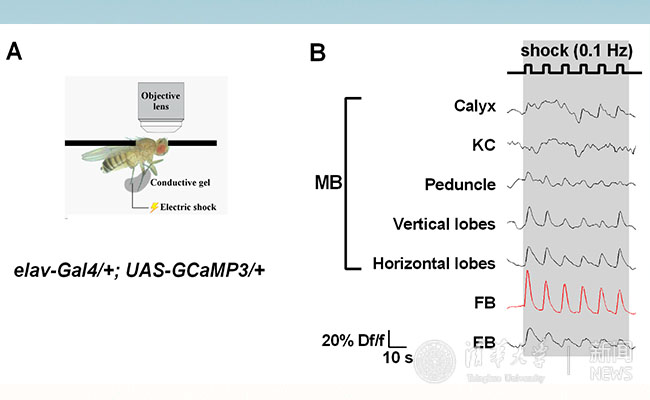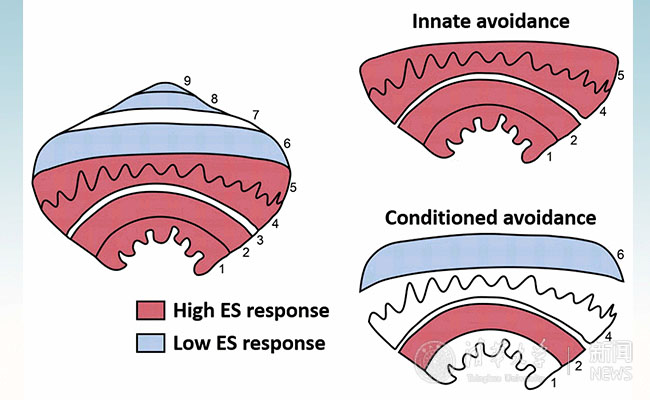Yi Zhong’s group published a Cell Reports article revealing the role of the Drosophila fan-shaped body neurons in nociceptive avoidance
Recently, a research team led by Professor Yi Zhong from the School of Life Sciences at Tsinghua University published a research article entitled Fan-Shaped Body Neurons in the Drosophila Brain Regulate both Innate and Conditioned Nociceptive Avoidance in Cell Reports, reporting an important role of Drosophila Fan-shaped Body (FB) neurons in nociceptive avoidance.
The living environment for animals is complicated and dangerous. If there is no effective escape mechanism to avoid noxious stimuli, it is hard for animals to survive. The avoidance of noxious stimuli consists of two parts; one is innate avoidance, such as escaping after being stabbed by a sharp object, or burning; the other is conditioned avoidance. For example, once a mouse receives electric shocks in room A which is not initially a dangerous room, it will couple room A with electric shock damage. Even if there is no electric shock in room A later, it will still avoid the room as it has the electric shock.
Two kinds of nociceptive avoidance behaviors also exist in fruit flies. Previous studies in fruit flies mainly focused on the peripheral nervous system, and little is known about how the central nervous system processes nociceptive information and guides avoidance behavior. The authors set up automatic stimulation equipment and a living calcium imaging recording device based on two-photon microscopy. The living brain of the transgenic fly with the calcium ion indicator protein GCaMP3 was dissected and the response to noxious electric shock stimulation was recorded. The results showed that the fan-shaped body (FB) located in the middle of the brain responded strongly to such noxious stimuli. Since the FB is a complex multi-layer structure, the authors further investigated electric shock-induced responses in different FB layers using multiple Gal4 lines. The data showed that different FB layers responded differently to an electric shock, and the responses of the ventral layers were higher than of the dorsal layers.

Fig 1 In vivo Calcium recording
Do such shock-induced responses play a role in the nociceptive avoidance behavior of Drosophila? The authors conducted behavioral experiments to explore this question. The FB neurons were found to be necessary in avoiding noxious electrical stimulation or noxious thermal stimulation. In addition, if the stimulus was not noxious (for example, if the fly encountered a disgusting smell), its avoidance behavior was not affected by the activity of FB neurons. Flies also avoided the area where the FB neurons were artificially activated, and this "avoidance" could be conditionally learned. Moreover, the author found that the FB not only participates in innate avoidance, but also participates in conditioned avoidance. In such behavioral experiments, the flies learnt to avoid an odor coupled with noxious electrical stimulation. The activity of FB neurons was found to be required in such avoidance behavior. Interestingly, different FB layers had different roles in both innate and conditioned avoidance behavior.

Fig 2 Different FB layers take part in different avoidance behaviors
Dr. Wantong Hu, Yiqing Peng, and Jiameng Sun at the School of Life Sciences at Tsinghua University are the co-first authors of this article. Dr. Qian Li and Dr. Yi Zhong are the corresponding authors of this article. Fang Zhang, Dr. Xuchen Zhang, Lianzhang Wang, and Bohan Zhao also contributed to this study. This work was supported by grants from the National Natural Science Foundation of China, the National Basic Research Project (973 program) of the Ministry of Science and Technology of China, and the Tsinghua-Peking Joint Center for Life Sciences.
Paper link: https://www.cell.com/cell-reports/fulltext/S2211-1247(18)31118-5
Contributor: School of Life Sciences
Editors: John Olbrich, Guo Lili

